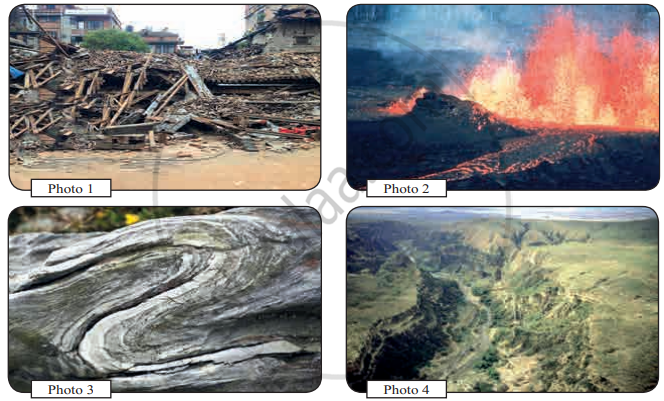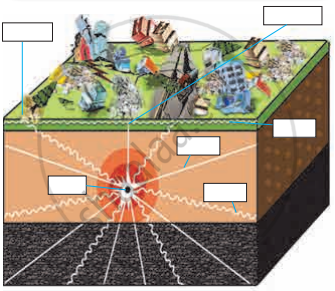Advertisements
Advertisements
Question
Observe the following pictures and discuss the questions in the class.

- What might be the reasons behind buildings collapsing in photo 1?
- Which event is depicted in photo 2? What impact does it bring about in the surroundings?
- In photo 3, what could be the reason behind the bend in the rock strata?
- What could be the reason behind the difference in altitudes of the land and the steepness of the slope in photo 4?
- Classify the events in the photos into sudden and slow movements.
- Example of which of these movements is not likely to be found in the mainland of the Indian sub-continent?
Solution
- The major reason behind the buildings collapsing in photo 1 is the occurrence of earthquakes.
- The volcanic eruption and flowing of lava are depicted in photo 2. Heavy loss of life and property is experienced when the lava flows to the surrounding area.
- Due to compression of sediments within the earth's interior and pressure from overlying layers the rock strata seems to be bend.
- The reason could be the displacement of rock due to vertical movement. It may form plateau on block mountains.
- Sudden movements are earthquakes and volcanoes in photos 1 and 2. Slow movements are the formation of folds and formation of plateaus or block mountains in photos 3 and 4.
- The volcanic eruptions are not found in the mainland India sub-continent.
APPEARS IN
RELATED QUESTIONS
On 19th August 2018, around 300 people died in Indonesia. Many buildings collapsed. Many roads broke apart. A tsunami was generated.
- What was the cause behind these events?
- What actually happened during this natural event?
- Name the energy waves involved in this natural event.
- Observe the diagram and label the boxes.

Observe the following diagrams. Try to understand the different types of fold shown in the diagram and match it with its characteristics. Write the name of the fold in the space given below.

A) Symmetrical:
- The axial plane is vertical.
- Limbs are inclined at same angle.
B) Asymmetrical:
- The axial plane is inclined.
- The limbs are inclined at different angles.
C) Overturned:
- One limb lies above the other limb.
- Limbs slope unequally in the same direction.
D) Recumbent:
- The axial plane is almost horizontal.
- One limb lies over the other in a horizontal direction.
E) Isoclinal:
- The limbs slope in the same direction with the same amount.
- The axial plane may be vertical, inclined, or horizontal.
- The slope of some portion of limbs is near vertical.
Assertion A: Intensity of an earthquake is a measurement of the energy released during an earthquake.
Reasoning R: Mercallis scale is used to measure the intensity of an earthquake.
Identify the correct correlation:
A: Assertion; R: Reasoning
A: South-East Asia, Japan, and islands in the Pacific Ocean are most vulnerable to earthquakes and volcanic eruptions.
R: They are located in the 'Ring of Fire'.
Identify the correct group:
Differentiate between Mercalli scale and Richter scale
